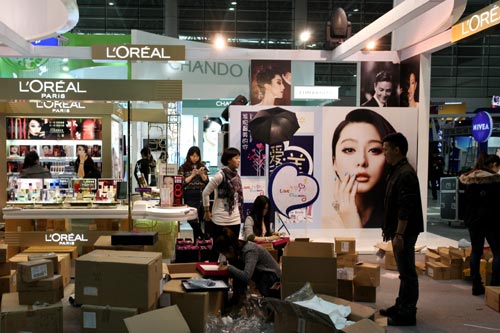L'Oreal targets middle class
Updated: 2013-04-11 07:19
By Li Fangfang (China Daily)
|
|||||||||||
|
L'Oreal Group's booth at a brand exhibition in Fuzhou, Fujian province, in March. The French company operates in more than 170 Chinese cities. Provided to China Daily |
L'Oreal Group, the world's largest cosmetics and beauty company, plans to further develop China's luxury beauty market, seeing huge potential from the next generation of luxury consumers, its rising middle class and smaller cities.
"Chinese consumers are at the heart of L'Oreal's focus and energies. A potential 250 million new Chinese consumers will be using L'Oreal's products in the next 10 to 15 years, making China the No 1 contributor to our ambition of winning 1 billion new consumers," said Jean-Paul Agon, chairman and chief executive officer of L'Oreal Group.
"A significant portion of these consumers will be recruited by our luxury brands, the segment where L'Oreal has a long-term lead and where it will continue to influence the shape of its future," he added.
Though L'Oreal's luxury brands account for about one-third of its total business in China at the moment, "we see huge potential from the rising middle-class and consumption power in lower-tier cities", said Agon.
The French company operates in more than 170 cities in its third-largest market. By adding its Yves Saint Laurent Beaute brand next month to its current portfolio of 10 brands available in China, L'Oreal hopes to enhance its luxury portfolio to meet the needs of Chinese women and men across age, economic and lifestyle categories.
"Thus we can offer luxury beauty products for all generations at all price ranges to Chinese consumers," said Agon. "The luxury brands business will for sure work to make China our largest market in the world someday."
According to Nicolas Hieronimus, president of L'Oreal Luxe, the company's luxury product business doubled every four years during the past eight years in China.
"We hope to keep the pace and in 2014 or late 2015, we expect Chinese consumers will be our No 1 group in the world," said Hieronimus. "It is just a beginning, and is set to boom."
Since L'Oreal first introduced its Lancome brand to China in 1993, its growth rate has been 1.3 times that of the segment's average.
"Our brands have flourished and we have consistently outperformed the market growth for the past 10 years," said Hieronimus.
Both Agon and Hieronimus said that the company's confidence in China comes from the huge potential from China's rising middle class, especially those under 30, as well as lower-tier cities.
Statistics show that China has 13 cities with a population of more than 10 million, 88 cities with more than 5 million inhabitants, and 335 cities with more than 1 million people.
The middle class, with an annual household income of more than $11,730, will grow from 141 million in 2010 to 400 million in 2020.
According to US consulting firm Bain & Company, China's luxury market doubled in size from to 2008 to 14 billion euros ($18.4 billion) in 2012, ranking fifth in the world. However, the country has the most luxury consumers.
Moreover, fashion magazine Elle found in a global survey conducted in January that Asian women spend more on cosmetics than those in any other regions, especially those aged between 25 and 34.
L'Oreal reported 12.4 percent year-on-year growth in 2012, with revenue of 12.05 billion yuan ($1.94 billion) in China. It was the 12th consecutive year the company gained double-digit annual growth in the world's third-largest cosmetics market.
L'Oreal's US competitor, Estee Lauder, also plans to grab more profit from China's luxury beauty market through its new brand, Osiao, which is tailored for Asian skin types.
Today's Top News
Police continue manhunt for 2nd bombing suspect
H7N9 flu transmission studied
8% growth predicted for Q2
Nuke reactor gets foreign contract
First couple on Time's list of most influential
'Green' awareness levels drop in Beijing
Palace Museum spruces up
Trading channels 'need to broaden'
Hot Topics
Lunar probe , China growth forecasts, Emission rules get tougher, China seen through 'colored lens', International board,
Editor's Picks

|

|

|

|

|

|






